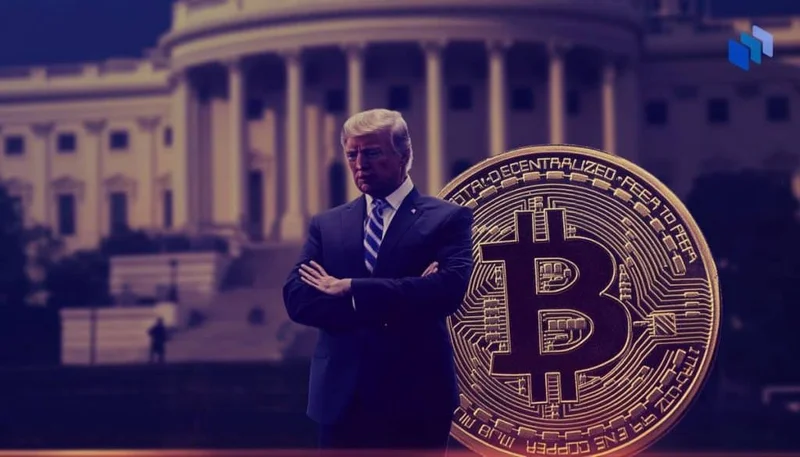On September 18, the US Federal Reserve announced a 50 basis points cut in the federal funds rate target range to between 4.75% and 5.00%. It is the first rate cut by the Fed in four years, marking the commencement of a new round of global monetary easing. Besides countering the slowdown of the US economy and uncertainties in the global economic outlook, the rate cut will have profound implications for various asset classes, including blockchain and cryptocurrencies. This article will delve into the impacts of this Fed rate cut on the blockchain industry, analyzing the opportunities and challenges that lie ahead.

Liquidity Injection: Fueling Capital Inflow to Blockchain Sector
The most immediate outcome of the rate cut is lower funding costs, increased liquidity in the financial system. For the blockchain industry, this translates into a significantly improved financing environment. Blockchain, being a technology-intensive sector, heavily relies on venture capital and innovation funds. With lower interest rates, investors will be on the lookout for high-return, high-growth investment opportunities, and the blockchain and cryptocurrency space, with its unique decentralized nature and technological potential, will attract substantial capital inflows.
Indeed, blockchain startups and technology innovation projects around the world have already demonstrated strong momentum in the capital market. Decentralized finance (DeFi), non-fungible tokens (NFTs), and the Web 3.0 ecosystem have emerged as the three major innovation tracks in blockchain in recent years. The Fed's dovish policy stance is likely to further stimulate this trend, driving capital flows into these high-potential areas.
Shift in Capital Allocation and Acceleration of Innovation
Under the Fed's easing cycle, venture capital investment in the blockchain industry will shift from the pure cryptocurrency sector to a wider range of blockchain technology applications, especially areas such as decentralized finance, supply chain, digital identity, and data security. These technology applications can bring broader economic benefits, particularly in terms of resolving the global supply chain crisis, digital economic development, and financial inclusion. Collaboration between traditional financial institutions and blockchain companies will become closer, driving the innovation and large-scale application of blockchain technology.
US Dollar Weakness and Enhanced Safe-haven Function of Cryptocurrencies
Rate cuts often come with US dollar weakness, and as global investors seek alternative stores of value, the safe-haven function of Bitcoin and other cryptocurrencies could be further enhanced. Bitcoin has long been touted as "digital gold," its status as an inflation hedge will be further solidified as the US dollar depreciates and the fiat monetary system comes under pressure. Prolonged US dollar weakness may lead global investors to partially shift their assets into digital currencies like Bitcoin, thus driving up demand in the cryptocurrency market and pushing prices higher.
From Monetary Policy to Financial Disintermediation
The Fed's rate-cutting action not only has the potential to fuel a short-term rally in Bitcoin prices, but also may further accelerate financial disintermediation. The decoupling of cryptocurrencies from the fiat monetary system, coupled with blockchain technology's re-engineering of financial infrastructure, is gradually diminishing the influence of traditional monetary policy. The rate cut may lead to higher opportunity costs of holding fiat currencies, prompting more investors to consider diversifying their portfolios, with cryptocurrencies and decentralized assets becoming important alternatives.
In the context of financial disintermediation, the influence of national sovereign currencies weakens, and the rollout of central bank digital currencies (CBDCs) will become an important countermeasure. The Fed's dovish stance may accelerate the research and development and issuance of CBDCs in various countries, further promoting the widespread application of blockchain technology in the global financial system.
Explosive Growth of DeFi and Decentralized Systems
The decentralized finance (DeFi) sector has been growing rapidly since 2020, and the Fed's rate cut undoubtedly provides a new opportunity for this sector to flourish. DeFi, as an indispensable part of the blockchain industry, provides financial services such as lending, trading, and derivatives through smart contracts, offering higher transparency and lower intermediary costs compared to traditional financial systems. As interest rates decline, returns in traditional financial markets diminish, and the high returns and innovative financial products on DeFi platforms will attract more capital and users.
Financial Innovation and Risk Challenges of DeFi
With reduced returns in traditional finance, users will increasingly seek high-yield opportunities offered by DeFi. DeFi is not only an alternative to the traditional financial system, but also represents a transformation of financial infrastructure. It reconstructs the design and operation of financial products through smart contracts and decentralized applications (dApps), bringing more flexible, efficient, and disintermediated services.
However, DeFi's rapid growth also brings new challenges, especially in terms of risk management and compliance. Due to its decentralized nature, DeFi platforms are prone to security vulnerabilities, smart contract risks, and market manipulation issues. With the Fed's rate cut, the large-scale inflow of funds into the DeFi market may further intensify these risks, and investors should remain vigilant, especially in the context of an immature regulatory environment.
Global Synchronization of Monetary Policies and Globalization of Blockchain
As the leader among global central banks, the Fed's rate cut often triggers other central banks to adjust their monetary policies in sync, pushing the global economy into an easing cycle. Multiple countries have already started to follow the Fed's lead and adopted rate-cutting measures to counter the global economic slowdown. This globally synchronized easing policy not only has a profound impact on traditional financial markets but also offers opportunities for the globalization of the blockchain industry.
Globalization of Blockchain and Policy Uncertainty
With declining interest rates globally, the internationalization and cross-border application of blockchain technology will accelerate. For instance, blockchain can help solve the problems of transparency and efficiency in the global supply chain, particularly in cross-border trade sectors such as logistics and manufacturing. Meanwhile, policy adjustments by central banks will also drive the research and development of central bank digital currencies (CBDCs), which will further promote the application of blockchain technology in global financial infrastructure.
However, the asynchronicity of global monetary policies and the uncertainty of regulatory policies in various countries may pose certain obstacles to the globalization of the blockchain industry. The differences in regulatory frameworks, tax policies, and legal environments among different countries remain significant challenges for cross-border blockchain applications.
Double-edged Sword of Regulation and Policy
While the rate cut brings numerous opportunities for the blockchain industry, especially in terms of capital inflows and technological acceleration, the changing global regulatory environment could become a potential impediment. The rapid development of blockchain technology and cryptocurrencies has drawn significant attention from regulatory agencies. As blockchain technology matures, countries around the world are likely to strengthen regulations, especially in areas such as anti-money laundering (AML), combating the financing of terrorism (CFT), and market manipulation.
Regulatory Dilemma and Self-regulation of Blockchain Industry
Blockchain technology is inherently decentralized, differing in nature from the traditional financial system. The Fed's monetary policy adjustment will compel global central banks and regulatory agencies to pay more attention to the transparency and compliance of digital asset markets. Although tighter regulations may suppress the development of the blockchain industry in the short term, in the long run, a sound regulatory framework will help enhance market confidence and promote the legalization and standardization of blockchain technology in the mainstream financial sector.
At the same time, it is imperative for the blockchain industry to accelerate self-regulation, establish industry standards, enhance transparency and security, and ensure sustainable development under the new monetary environment.
Why It Impacts the World
Global Status of the Dollar: The US dollar is the world's reserve currency, used by many countries for their foreign exchange reserves, international trade, and the pricing of commodities like oil. Changes in the Federal Reserve's monetary policy impact the dollar exchange rate, affecting global financial markets and economic activity.
Global Capital Flows: The Fed's interest rate adjustments influence global capital flows. Lower rates make US assets less attractive, leading to capital outflows seeking higher returns elsewhere. This impacts capital flows, exchange rates, and asset prices in emerging markets and other economies.
Influence on Global Central Banks' Policies: The Fed's interest rate decisions often drive monetary policies in other countries. Fed rate cuts may prompt other central banks to adopt synchronized easing to prevent their currencies from appreciating too much against the US dollar, which could hurt their export competitiveness.
Interconnections in Global Trade and Growth: The global economy is highly connected, and the US, as the world's largest economy, affects global trade, investment, inflation, and economic growth through its monetary policy. Fed rate cuts signal expectations of a slowdown in US economic growth, potentially affecting confidence in the global economic recovery.
What Rate Cuts Mean
Stimulating Growth: Lower interest rates make it cheaper for businesses and individuals to borrow, encouraging investment and consumer spending, boosting economic growth.
Easing Financial Market Stress: Rate cuts increase liquidity in financial markets, lowering borrowing and investment costs, alleviating funding pressures on businesses and financial institutions.
Promoting Inflation: Rate cuts often aim to raise inflation towards central bank targets (e.g., the Fed's 2% target). Lower rates encourage more spending and investment, pushing prices higher.
Weakening Currency: Interest rate cuts typically lead to currency depreciation, making exports more competitive internationally and boosting trade.
What You Should Start Doing
Rebalance Portfolio: In a low-rate environment, traditional fixed-income assets (like bonds) offer lower returns. Consider adjusting your portfolio to include more stocks, real estate, and other risk assets. Explore alternative assets like cryptocurrencies, which may perform better in a low-rate environment.
Monitor Currency Fluctuations: Rate cuts usually lead to a weaker US dollar, impacting exchange rates in international markets. If you engage in cross-border trade or have foreign exchange investments, monitor exchange rate movements closely and develop strategies to manage currency risks.
Consider Refinancing or Borrowing: With lower interest rates, individuals and businesses may want to refinance, buy a home, or borrow to expand business operations. The low-cost financing environment can be a good time to expand or make capital investments.
Manage Cash Flow and Debt: While rate cuts reduce borrowing costs, they also reduce returns on savings accounts and low-risk investments. Reassess cash flow management strategies to maintain reasonable returns in the low-rate environment while controlling debt levels to avoid overreliance on cheap funding.
Be Aware of Policy and Market Risks: Interest rate cuts may provide short-term liquidity to markets, but looking ahead, asset prices may face volatility risks if economic weakness or other uncertainties intensify. Investors and businesses need to stay vigilant, monitoring global macroeconomic conditions and policy changes.
Rate cuts are not simply a tool to manage the economy; they signal potential greater economic uncertainty, making risk management and strategy adjustments even more crucial.
FAQ
Q: How Will The Fed Interest Rate Cut Impact The Fundraising Landscape For The Blockchain Industry?
A: The Federal Reserve’s interest rate cuts directly lower the cost of capital and increase liquidity in financial markets. For the blockchain industry, particularly for blockchain startups, this translates into more investment opportunities and funding channels. In a low-interest environment, venture capital and investment institutions are likely to increase their focus on blockchain and related technologies, especially in high-growth areas like Decentralized Finance (DeFi), Non-Fungible Tokens (NFTs), and Web 3.0. This will expand the application of blockchain technology and accelerate innovation.
Q: How the Federal Reserve's Interest Rate Cuts Affect the Cryptocurrency Market, Particularly Bitcoin?
A: Interest rate cuts typically lead to a weaker dollar, prompting investors to shift towards safe-haven assets, with Bitcoin being one of them. Long regarded as "digital gold," Bitcoin's appeal increases in the face of fiat currency depreciation and growing economic uncertainty. Following a rate cut, the expectation of dollar devaluation is likely to boost demand for Bitcoin, potentially driving up its price. Additionally, global investors may increase their allocations to cryptocurrencies to diversify their investment risks, thereby promoting overall growth in the crypto market.
Q: What Impact Do Federal Reserve Interest Rate Cuts Have on the Development of the Decentralized Finance (DeFi) Sector?
A: Federal Reserve interest rate cuts lead to a decline in returns within the traditional financial system, making DeFi platforms more attractive due to their decentralized nature and relatively higher yields. In a low-interest-rate environment, financial services offered by DeFi platforms, such as lending, staking, and liquidity mining, become increasingly appealing. Rate cuts may accelerate the expansion of the DeFi market, driving user growth and capital accumulation. However, this growth also comes with market volatility and security risks, necessitating enhanced risk management and the security of smart contracts within the industry.
Q: How Do Federal Reserve Interest Rate Cuts Affect the Development of Central Bank Digital Currencies (CBDCs) Worldwide?
A: Federal Reserve interest rate cuts not only impact global financial markets but also accelerate the research and development of Central Bank Digital Currencies (CBDCs) in various countries. Following a rate cut, central banks will focus more on how to enhance the stability and liquidity of the financial system through digital currencies. As the global economy enters a period of easing, the launch of CBDCs will serve as an effective response to financial disintermediation and the rise of the digital currency market. Central banks worldwide will expedite the advancement of CBDCs to address the challenges posed by blockchain technology to traditional financial systems and maintain control over financial infrastructure.
Q: What Regulatory Risks Might Arise from Federal Reserve Interest Rate Cuts, and How Should the Blockchain Industry Respond?
A: While Federal Reserve interest rate cuts may bring increased capital inflows and growth opportunities to the blockchain industry, they can also heighten regulatory pressures. Regulatory bodies worldwide are intensifying oversight of digital assets, decentralized finance, and cryptocurrencies, particularly in areas such as anti-money laundering, combating terrorist financing, and market manipulation. The blockchain industry must proactively address these challenges by enhancing compliance, transparency, and security, establishing robust industry standards, and actively engaging with regulators to ensure the long-term sustainable development of the sector.
Related Articles

What is SparkLend? A Beginner-to-Advanced Guide to Decentralized Lending Made Easy
SparkLend is a decentralized, non-custodial liquidity market protocol built on the Ethereum blockchain. Simply put, it functions like a bank without intermediaries, allowing users to borrow and lend d
June 26, 2025
What is sUSDS? How Do I Acquire sUSDS?
This guide will walk you through Sky Savings’ sUSDS and sUSDC—your gateway to earning yield with stablecoins while keeping your funds secure.Sky Savings: Your Journey to Stablecoin Yields Begins HereW
June 26, 2025
What is SparkLend? A Complete Guide from Beginner to Pro
SparkLend is a decentralized, non-custodial liquidity market protocol that allows users to participate as lenders or borrowers. Lenders provide liquidity to earn passive income, while borrowers can ta
June 24, 2025
What Exactly Does Spark Protocol Do? A Complete Guide
This guide will walk you through Spark Protocol — an innovative platform designed to tackle the long-standing issue of fragmented liquidity in the DeFi space. You'll learn how to earn yield, borrow as
June 24, 2025
RXS Token Trading Guide: From Presale to Uniswap – A Complete Walkthrough
This guide will walk you through the trading process of the RXS Token, from the restrictions during the presale phase to free trading on Uniswap, helping you trade securely and efficiently.1. Introduc
June 24, 2025
